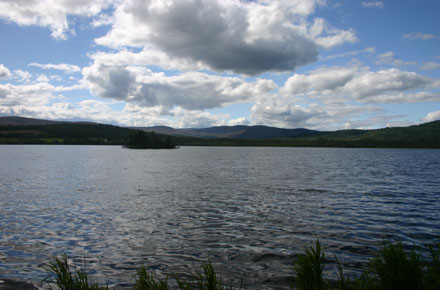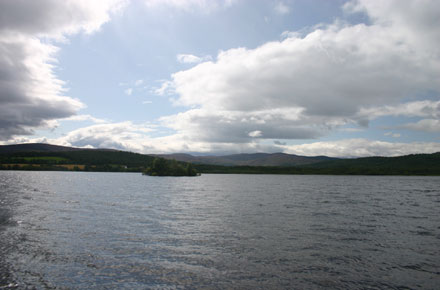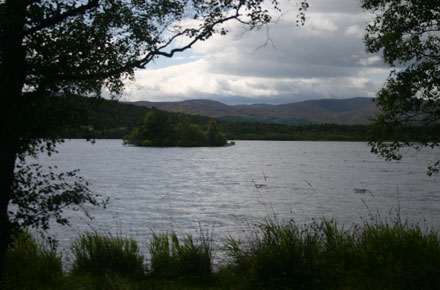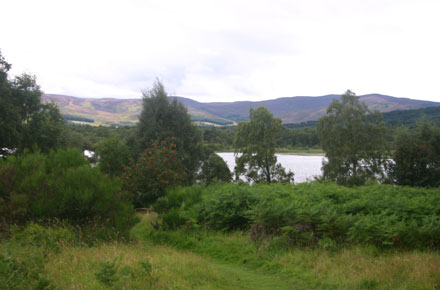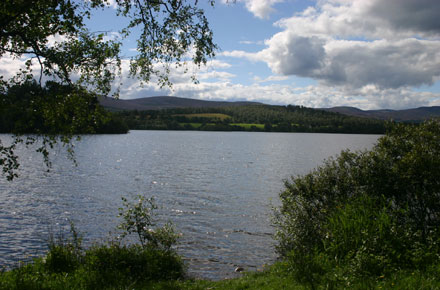Muir of Dinnet (Loch Kinord and Burn O'Vat)
Key information: Muir of Dinnet (Loch Kinord and Burn O'Vat) 
- Circuit beautiful Loch Kinord below the first mountain of the Highlands on Aberdeenshire's Deeside, then explore the ludicrously pretty mini-glen that leads to a fabulous glacially-scoured cauldron in the hillside where a 17th Century brigand hid behind the waterfall.
- A rich variant from the highland trails. Wonderful undulating mixed open woodland, with heather beneath. A wide variety of interesting wildlife: a Nature Reserve within a National Park.
- Ancient traces of humanity: an Iron Age stone hut circle a 2,000 year old crannog (man-made habitation-island); a Celtic cross, a royal castle-island, and hilly farmland.
Walkopedia rating
- Walkopedia rating87.5
- Beauty30
- Natural interest16.5
- Human interest14
- Charisma30
- Negative points3
- Total rating87.5
- Note: Negs: popularity, esp. Burn O'Vat
Vital Statistics
- Length: Variable, up to 9km
- Maximum Altitude: N/A
- Level of Difficulty: Moderate
This walk description page is at an early stage of development, and will be expanded over time. Your comments on this walk, your experiences and tips, and your photos are very welcome.
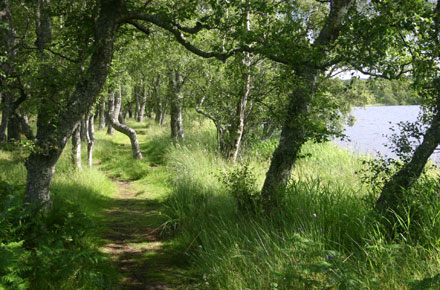
WALK SUMMARY
This beautiful area of heathery moor, in the process of natural reforestation with open birch forest, and two lovely lakes, has a wealth of natural and historical interest. It is a Nature Reserve within a National Park.
Wonderful undulating mixed open woodland sheltering boggy former glacial dips and the famous lakes, with heather hills beneath, all backdropped by the ravishing beauties of the highland hillsides and the looming presence of Morven, the first mountain of the Deeside Highlands behind. A wide variety of interesting wildlife reflect the various specialist areas: a range of waterfowl and summer-nesting osprey; woodland birds including the willow warblers; and a multitude of dragon and damsel flies and moths.
This small area is rich in traces of ancient humanity: an Iron Age stone hut circle (of surprising size); a 2,000 year old crannog (man-made habitation-island) which once held a huge round hut housing up to 20 people and was apparently in use to the Middle Ages; a fine granite Celtic cross, 1,200 years old; an island once home to a royal peel tower; and hilly farmland showing traces of thousands of years of cultivation.
The area is just as rich in the remains of the last Ice Age. The two lakes are kettle holes, holes forced by the weight of enormous lumps of slow-melting ice; there are ridges which are of rocks dumped by sub-glacier rivers; the extraordinary smooth-sided circular cauldron indicates how big and powerful the now-small river must one have been.
Circuit beautiful Loch Kinord, admiring the crannog in its sparkling watery setting, with the heathery South Deeside hills behind or wander through pretty lakeside trees then swing out into the woodland and farming remains to the north, admiring the cross and hut circle in particular. Or explore the fascinating “raised bogs” of Parkins Moss.
Cut through regenerating moorland birch and pine woods, walking along the tops of eskers – ridges of rubble that were formed in stream beds below glaciers – to the beginning of the Burn O’Vat.
Explore the ludicrously pretty little glen, known as the Burn O’Vat, that leads to the fabulous cauldron where a 17th Century brigade hid behind the waterfall. It was much admired by Queen Victoria.
You won’t be alone in the Burn O’Vat in particular, as it is a deservedly popular tourist site on Aberdeenshire’s Deeside, between Aboyne and Ballater. Get there early or late if you can.
This area is marvellous at any time of year, although Summer, while busiest, has the best (most consistent) weather.
There is a good hut at the Burn O’Vat carpark, with excellent information on the area and its history.
Other accounts: share your experiences
Your comments on this walk, your experiences and suggestions, and your photos are very welcome. Where appropriate, you will be credited for your contribution.
Safety and problems: All walks have inherent risks and potential problems, and many of the walks featured on this website involve significant risks, dangers and problems. Problems of any sort can arise on any walk. This website does not purport to identify any (or all) actual or potential risks, dangers and problems that may relate to any particular walk.
Any person who is considering undertaking this walk should do careful research and make their own assessment of the risks, dangers and possible problems involved. They should also go to “Important information” for further important information.
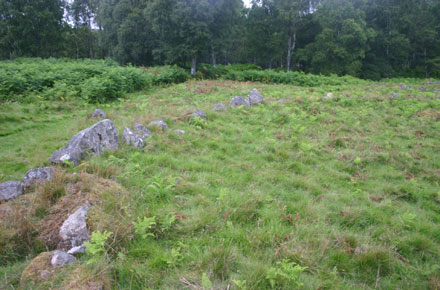
Anyone planning an expedition to this place should see further important information about this walk.
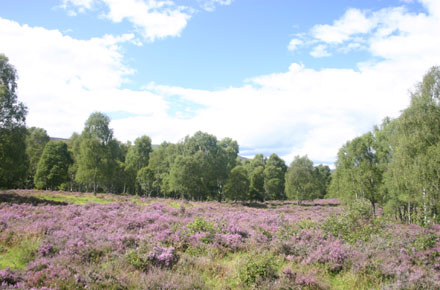
Responsible travel matters, a lot. How you travel will make a real difference - for better or worse. PLEASE consider this when making plans. Read more


